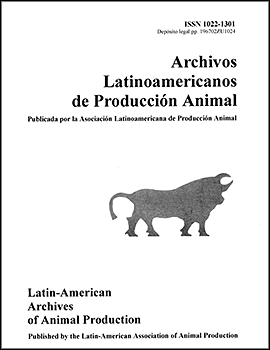
|
Archivos Latinoamericanos de Produccion Animal
Asociacion Latinoamericana de Produccion Animal
ISSN: 1022-1301
EISSN: 1022-1301
Vol. 16, No. 4, 2008, pp. 201-209
|
 Bioline Code: la08028
Bioline Code: la08028
Full paper language: English
Document type: Research Article
Document available free of charge
|
|
|
Archivos Latinoamericanos de Produccion Animal, Vol. 16, No. 4, 2008, pp. 201-209
| en |
Diurnal ingestive behavior of Nellore steers receiving increasing levels from supplement in pasture of Brachiaria brizantha*
Silva, R. Rodrigues; do Prado, I. Nunes; da Silva, F. Ferreira; Pinto de Carvalho, G.G.; de Souza, D. Ribeiro; de Santana, H.A. & Breda, A. Lima
Abstract
The objective of this experiment was to evaluate the diurnal ingetive behavior Nellores steers with increasing levels of energy and protein supplemention by raising in pasture of Brachiaria brizantha. The on-farm trial was developed at Boa Vista Farm in conjunction with Bahia State University, southwestern Bahia, Brazil, where forty 26-month-old Nellore steers with the initial weight of 371.0 ± 14.9 kg were previously accommodated to the experimental conditions for 14 days; they were randomly allotted in the following treatments: T 00 = mineral salt, T 03 = 0.3%, T 06 = 0.6%, and T 09 = 0.9% of energy and protein supplementation for 84 days. The animals were visually observed at 10-minute intervals for two periods of 12 hours from 6:00 am to 6:00 pm. Time for ruminating (P<0.06) had cubic effects; time for grazing (P<0.00001) and idling (P<0.00006) had quadratic effects while time for feeding had increasing linear effects (P<0.00001). The total of feed dry matter intake either in kg/animal/day or percentage (%) of the live body weight were not affected by increasing the levels of energy and protein (P>0.15). However, the total of dry forage intake and the fiber contents evaluated in neutral and acid detergent were linearly reduced (P<0.0002). Furthermore, the total time of chewing the number of bolus, and the ruminating time per bolus had cubic effects (P<0.0001); the chewing number per bolus was linearly reduced (P<0.000001); the number of grazing events (P<0.15) and the time of feeding was linearly increased (P<0.000001) although each grazing event had its average time linearly reduced (P<0.000001); the number of ruminating (P<0.02), idling events (P<0.000001), and time for each ruminating event (P<0.0002) had quadratic effects. Finally, the number of events at trough had cubic effects (P<0.000001) but the time of each idling event was not modified by the treatments (P>0.15). Therefore, it is necessary to pay special attention to the diet composition for raising beef-cattle and to the amount of feed in conjunction with both composition and ratio of pasture to concentrate because some diurnal behavior which have affected on the ingesting performan-ce of Nellore steers.
Keywords
Cattle, Ethology, Idle, Rumination, Grazing event
|
| |
| es |
Comportamiento diurno del consumo en novillos Nellore en pastos de Brachiaria brizantha y recibiendo niveles crecientes de suplemento
Silva, R. Rodrigues; do Prado, I. Nunes; da Silva, F. Ferreira; Pinto de Carvalho, G.G.; de Souza, D. Ribeiro; de Santana, H.A. & Breda, A. Lima
Resumen
El objetivo de este experimento fue evaluar la ingesta diurna con niveles crecientes de suplementos de energía y proteína por novillos Nellore en pastoreo, en pastos Brachiaria brizantha. El ensayo en campo se desarrolló en la granja Boa Vista, en conjunto con la Universidad del Estado de Bahia, en el suroeste de Brasil, donde el 40 novillos Nellore de 26 meses de edad con un peso inicial de 371,0 ± 14,9 kg fueron acomodados a las condiciones experimentales por 14 días, asignados aleatoriamente en los siguientes tratamientos: T 00 = sales minerales, T 03 = 0,3%, T 06 = 0,6%, y T 09 = 0,9% de suplemento de la energía y de proteínas por 84 días. Los animales fueron observados visualmente a intervalos de 10 minutos durante dos períodos de 12 horas de 6:00 am – 6:00 pm. La hora de la rumia (P <0,06) tuvo un efecto cúbicos, el tiempo para el pastoreo (P <0,00001) y de ociocidad (P <0.00006) tuvo efectos de cuadráticos, mientras que el tiempo para la alimentación incrementos lineales (p <0,00001). El total de alimentos consumidos en materia seca en kg/animal/día o en porcentaje (%) de peso vivo no se vieron afectados por el aumento de los niveles de energía y proteína (P> 0,15). Sin embargo, el total de consumo de forraje seco y el contenido de fibra evaluado en detergente neutro yácido se redujo linealmente (P <0,0002). Además, el tiempo total de la masticación y el número de bolos, el tiempo rumiando por bolo tuvo efectos cúbicos (P <0,0001), el número de mascadas por bolo se redujo de forma lineal (p <0,000001); el número de eventos de pastoreo (P <0,15) y el tiempo de la alimentación en el valle se aumentó linealmente (P <0,000001), aunque cada caso tiene su tiempo de pastoreo promedio lineal redujo (P<0,000001), el número de rumiantes P (<0,02), al ralentí eventos (p <0,000001 ), y el tiempo para cada evento de rumiantes (P <0,0002) tuvieron efectos de segundo grado. Por último, el número de eventos en el valle tuvo efectos cúbicos (P <0,000001), pero el tiempo de cada evento al ralentí no fue modificado por los tratamientos (P> 0,15). Por lo tanto, es necesario prestar especial atención en la composición de la dieta para aumentar la carne de ganado y en la cantidad de alimento en relación con la composición y proporción de pastos para concentrarse debido a que algunos comportamiento diurno que tienen influencia en el rendimiento de la ingestión de Nellore novillos afectados.
Palabras-clave
Ganado, Etología, Rumiación, pastoreo, descanso
|
| |
© Copyright 2008 Archivos Latinoamericanos de Produccion Animal.
Alternative site location: http://www.alpa.org.ve/ojs/index.php
|
|
